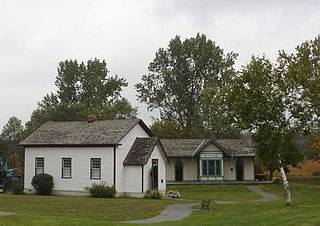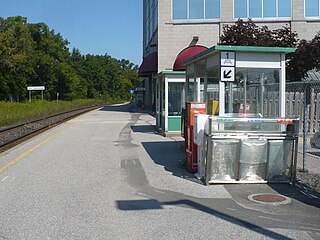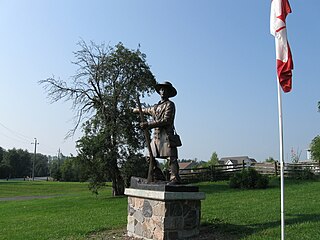
Aurora is a town in central York Region in the Greater Toronto Area, within the Golden Horseshoe of Southern Ontario, Canada. It is located north of the City of Richmond Hill and is partially situated on the Oak Ridges Moraine. In the Canada 2021 Census, the municipal population of Aurora was the 92nd largest in Canada, compared to 95th for the 2016 Census and 97th for the 2006 Census. Aurora is twinned with Leksand, Sweden.

Newmarket is a town and regional seat of the Regional Municipality of York in the Canadian province of Ontario. It is part of Greater Toronto in the Golden Horseshoe region of Southern Ontario. The name stems from the fact that the settlement was a "New Market", in contrast to York as the Old Market.

The Regional Municipality of York, also called York Region, is a regional municipality in Southern Ontario, Canada, between Lake Simcoe and Toronto. The region was established after the passing of then Bill 102, An Act to Establish The Regional Municipality of York, in 1970. It replaced the former York County in 1971, and is part of the Greater Toronto Area and the inner ring of the Golden Horseshoe. The regional government is headquartered in Newmarket.

Cobourg is a town in the Canadian province of Ontario, located in Southern Ontario 95 km (59 mi) east of Toronto and 62 km (39 mi) east of Oshawa. It is the largest town in and seat of Northumberland County. Its nearest neighbour is Port Hope, 7 km (4 mi) to the west. It is located along Highway 401 and the former Highway 2. To the south, Cobourg borders Lake Ontario. To the north, east and west, it is surrounded by Hamilton Township.

King is a township in York Region north of Toronto, within the Greater Toronto Area in Ontario, Canada.

Whitchurch-Stouffville is a town in the Greater Toronto Area of Ontario, Canada, approximately 50 km (31 mi) north of downtown Toronto, and 55 km (34 mi) north-east of Toronto Pearson International Airport. It is 206.22 km2 (79.62 sq mi) in area, and located in the mid-eastern area of the Regional Municipality of York on the ecologically-sensitive Oak Ridges Moraine. Its motto since 1993 is "country close to the city".

Oro-Medonte is a township in south-central Ontario, Canada, on the northwestern shores of Lake Simcoe in Simcoe County.

King City is an unincorporated Canadian community in the township of King, Ontario, located 40 kilometres (25 mi) north of Toronto. It is the largest community in King township, with 2,730 dwellings and a population of 8,396 as of the 2021 Canadian census.

Schomberg is an unincorporated village in northwestern King, Ontario, Canada. It is located north of the Oak Ridges Moraine and south of the Holland River.

Laskay is an unincorporated rural community in King Township, York Regional Municipality, Ontario, Canada. It is west of King City and Highway 400, and south of the King Road—Weston Road intersection.

Lloydtown is a hamlet located in King Township, Ontario, Canada. It is often associated with the surrounding and larger Schomberg, though it has its own unique characteristics and heritage.

Eaton Hall is a large house in King City, Ontario, Canada, built in the Norman style for Lady Eaton in 1938–39 on a 700-acre (2.8 km²) parcel of land. Lady Eaton and her husband, Sir John Craig Eaton acquired the land in 1920 and 1922 on recommendation from their friend Sir Henry Pellatt, who owned the nearby Mary Lake property. Lady Eaton moved into Eaton Hall three years after selling her city mansion, Ardwold. The house is adjacent to a body of water named Lake Jonda, and nestled within the temperate forests of King Township. Upon completion, it contained 72 rooms. It became a beloved gathering place for the Eaton Family, owners of the Eaton's department stores based in Toronto.
The King Township Public Library is a public library system that serves King Township, Ontario in Canada. It consists of four branches located in King City, Nobleton, Schomberg, and Ansnorveldt.

King City GO Station is a train and bus station in the GO Transit network located in King City, Ontario in Canada. It also serves the nearby communities of Nobleton, Oak Ridges, the northern parts of Maple, and other communities in King Township. It is a stop on the Barrie line train service.

Aurora GO Station is a railway station and bus station in the GO Transit network located on Wellington Street East between Yonge Street and Bayview Avenue in Aurora, Ontario, Canada. It is a stop on the Barrie line train service, and connects with York Region Transit local bus routes, and the GO Express Bus between Newmarket Bus Terminal and Union Station Bus Terminal.

Newmarket GO Station is a train and bus station in the GO Transit network located in the Old Davis Tannery Centre on the north side of Davis Drive East in Newmarket, Ontario, Canada, and is a stop on the Barrie line train service. It is a little over two kilometres east of the Newmarket Bus Terminal, at Davis Drive West and Eagle Street, which is a terminus for GO Bus, York Region Transit and Viva BRT services.
The Schomberg Fair is an annual agricultural fair held in late May in Schomberg, a community in the township of King in Ontario, Canada. It starts on the Thursday following Victoria Day, and runs through to Sunday. It is staged at the Schomberg Agricultural Fairgrounds, also known as the Schomberg Fairgrounds, which is adjacent to the Holland River.

Doon Heritage Village, located at the Ken Seiling Waterloo Region Museum, is a picturesque 25-hectare (60-acre) living history village that shows visitors what life was like in the Waterloo Region in the year 1914. It is located in the former Doon village, now part of Kitchener, Ontario, Canada, next to Homer Watson Park.

Jesse Lloyd was the founder of Lloydtown, Ontario and a leader in the Upper Canada Rebellion of 1837. Born in Springfield Township, Pennsylvania, he was the third son of Quakers William Lloyd and Susannah Heacock. The Lloyds, who were United Empire Loyalists, possibly came to Canada at Niagara in 1788 but soon returned to the United States. They likely immigrated permanently to Upper Canada in 1808. Upon arrival, they crossed the Niagara gorge and migrated north to settle in the 10th concession of King Township.
The municipal government of King, Ontario consists of the mayor and six councillors who are elected to office during the municipal elections in Ontario or who are acclaimed to office because their candidacy is unopposed. It also includes civic staff responsible for the operational affairs of the township.



















